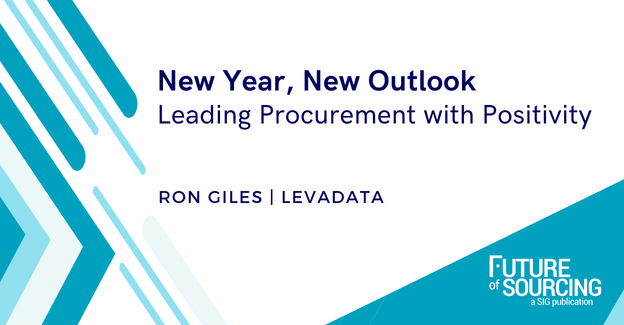"Recent major shifts in the market should provide a welcome change for procurement professionals, even if it doesn’t necessarily mean supply chain jobs will be dramatically easier," says Ron Giles, Strategic Sourcing Director at LevaData. Ron shares his thoughts on the future of procurement in 2023.
The holiday season presents a perfect opportunity for reflection and gratitude. And after a long year, procurement teams can look forward to a new outlook for 2023.
Being a procurement professional is not for the faint of heart. But, even so, the constant bombardment of issues related to cost, supply, quality, sustainability, risk, governance, and resilience has reached such a crescendo that a Gartner survey of supply chain professionals revealed that since the start of the pandemic, nearly 85% of these professionals indicate they have become tired and burned out.
This dismal stat leads anyone to reasonably ask: what could procurement and supply chain professionals possibly have to be thankful for right now?
Recent major shifts in the market should provide a welcome change for procurement professionals, even if it doesn’t necessarily mean supply chain jobs will be dramatically easier. In tandem with market changes, procurement professionals are heading into 2023 with a renewed focus on price optimization and an expanded role aligned with their heightened organizational value.
Market shifts: A better balance between supply and demand
We are already seeing a broad return to a balance between supply and demand and, in many cases, a likely oversupply situation that will lead to less “chasing parts” and more “chasing price” in the new year. Depending on the industry and category, this shift will occur at different rates.
The memory industry is already experiencing this reality, and for semiconductors, memory tends to be a leading indicator for predicting future trends. Between rising inflation and the reprioritization of consumer spending to other areas, such as travel and entertainment, the intense pace of technology purchases has slowed, making an oversupply almost inevitable. According to Gartner’s latest forecasts, global semiconductor revenue is projected to decline by 3.6% in 2023, totaling $596 billion; this is down from their previous forecast of $623 billion.
We are seeing similar trends for other components because of the slowdown in demand for PCs and smartphones, especially in China. Some components, such as microcontrollers, are continuing to exhibit longer lead times, but unless the economic outlook shifts significantly, all signs indicate supply chain professionals will be chasing supply less and, instead, focusing again on how to ensure they are getting the best prices.
Each industry and category has its own dynamics that influence supply and demand. Consider oil and gas, which will continue to be affected by the sanctions on Russia and OPEC+ targets, including The Group of Seven nations, Australia, and the European Union adopting a $60-per-barrel price cap on Russian oil. There are also specific pockets of specialty items tied to the auto and cloud businesses that will continue to face part shortages due to insufficient capacity for demand.
However, the general trend of slowing global economies suggests the days of broad-based supply shortages are over or will soon be, taking a little weight off many procurement team members’ shoulders.
New priorities: From continuous escalations to continuous negotiation
Because of the many challenges with component supplies over the past two years, most category and commodity managers have felt like they have been bouncing from one supply shortage escalation to another.
In 2023, this will shift, and their focus will migrate toward continuous negotiation, meaning procurement professionals will need to be on top of the market price dynamic to ensure they are getting the best pricing possible. This includes leveraging distribution or broker pricing because of the likelihood of excess inventory becoming available. With inflation pressure continuing and recession expectations remaining high, this will become incredibly important because suppliers will not want to reduce pricing as they continue to experience increased input costs for production.
However, procurement professionals armed with the right real-time market price and supply data will have a competitive advantage to continuously negotiate targeted pricing for specific component areas to ensure they are staying on the right pricing curve rather than being stuck with pricing that was last negotiated when suppliers had all the leverage.
Role transformation: Balancing and measuring upgrades for procurement professionals
Even with the shift in supply and demand and the likely return to more continuous price negotiations, the past two years have permanently changed how supply chain professionals will be measured going forward; however, this change has been for the better.
In the past, when continuous adequate supply was considered a “given,” businesses pushed most category and commodity procurement managers to focus solely on price. That simplistic approach is no longer useful or wanted. Procurement professionals should now be measured by a truly accurate––rather than theoretical––balance among cost, quality, delivery, innovation, sustainability, and resilience, in addition to other factors.
When it comes to procurement teams balancing strategies, diversification should also be top of mind. This may mean diversifying outside of China or simply ensuring there is more than one viable alternative for every part. Although this means the job of a procurement professional will be more complex, it also means they can take a more balanced and holistic approach in the long run.
With a new view on its role and responsibilities, procurement will likely have more influence in company strategy and business conversations because the role will now be seen as more than just a “cost” partner and as having comprehensive supply chain “trust” that must be carefully cultivated and protected.
And although procurement professionals may not be able to bask in gratitude for the work they did over the difficult past few years, the new year will provide a new beginning while positively transforming the industry. I look forward with a measure of thankful anticipation to the dynamics of better supply, more pricing leverage, and support for a more holistic, long-term approach to supplier management.
Region:









